Toshiba Chromebook 2: A Feast for the Eyes
by Jarred Walton on February 11, 2015 10:00 AM ESTToshiba Chromebook 2: A Beautiful Display
We’ve talked quite a bit already about the great display in the Toshiba Chromebook 2. Really, it’s the primary reason to buy this laptop over one of the alternatives, and as such it’s the best place to start our objective benchmarks. For these tests, we can’t create a color profile so what you get in the box is what you’re going to have to live with, meaning display quality becomes even a bit more important. On the other hand, it’s also important to remember that having really accurate colors is mostly a concern for imaging/video professionals or A/V enthusiasts, and you could certainly argue that neither group is really looking to use a Chromebook. For most users, the most compelling aspect is going to be the LCD viewing angles, as it means you don’t have to be positioned perfectly to get a legible screen:
TN panels always have problems with vertical viewing angles, which makes them a particularly bad choice on laptops as you’re frequently looking at the screen from slightly above rather than straight on. Over the years, at least that aspect has improved slightly, but it’s still clearly inferior to the experience that an IPS panel can offer – and don’t even get me started on the “from below” angles on TN, though that’s usually less of a concern. The Toshiba Chromebook 2 1080p display has no problems, regardless of viewing angle, and you reach the point where the angle is far too oblique to be useful before you have any issues with color shifting. Let’s move on to the color accuracy figures.
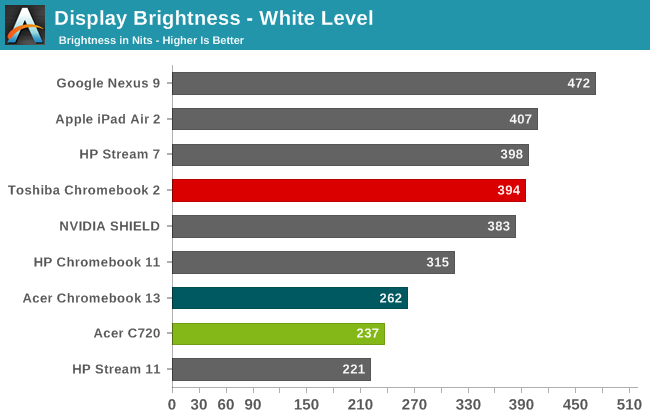
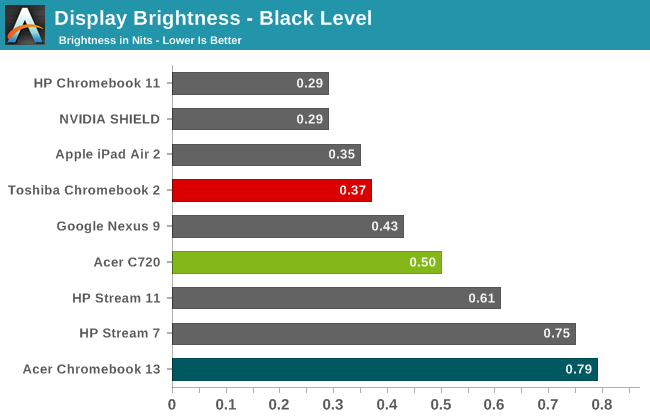
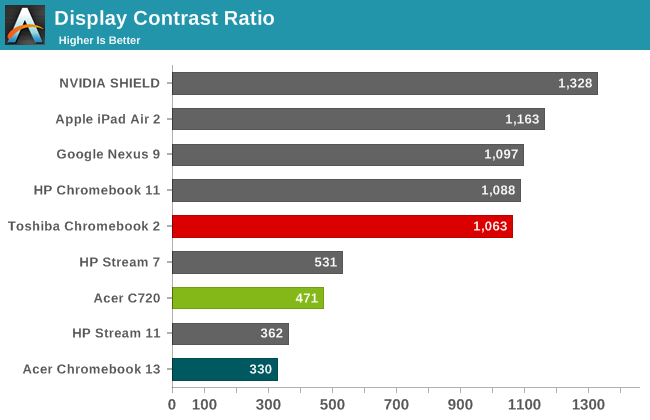
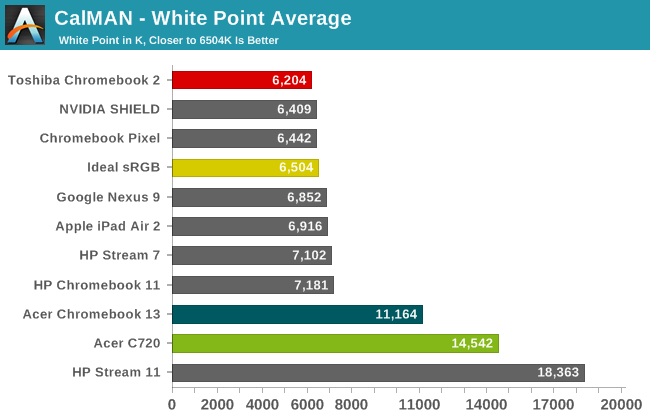
The maximum brightness of nearly 400 nits is great to see, as it makes this laptop useable even in outdoor environments, though reflections from the glossy display can still be a problem. The black levels at maximum brightness are 0.371 as well, which while not perfectly black are still closer than what you’ll see on most other laptops. Combined, we end up with a contrast ratio of 1063:1, though I should note that contrast improved at 200 nits to 1291:1 thanks to a proportionally better black level. The white point is also quite good, coming closer to the desired 6504K than any other Chromebook we’ve tested so far.
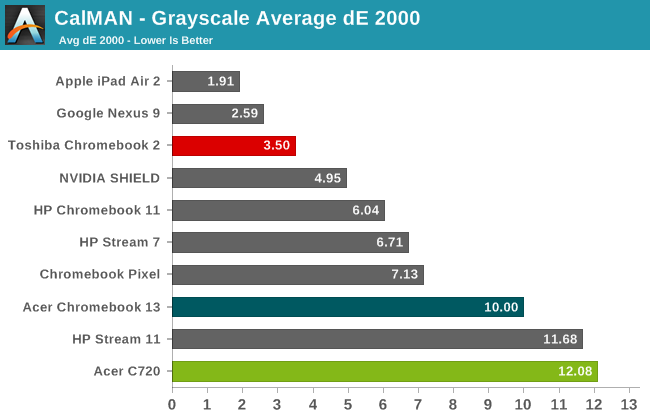

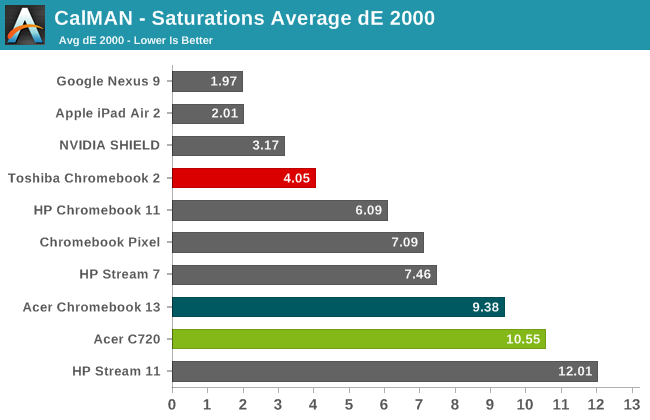
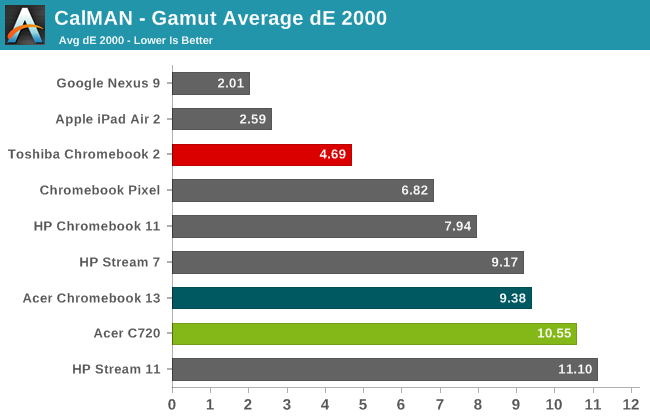
Delta E values could still be improved, but it has to be said that the Toshiba display still rates far better than the vast majority of Windows laptops we’ve tested. There are definitely colors that miss the mark, but in most of our tests the average Delta E ends up being around 4.0, which is higher than the desired average of 3.0 but quite a bit lower than the point where inaccuracies start to become distracting (6.0). The only displays we’ve tested in the above charts that do better overall are on the Nexus 9 and iPad Air tablets, and those are the two best tablet displays we’ve tested. When you look at the results of the other Chromebooks (including the Pixel), Toshiba really stands out from the crowd of mediocre color quality.
If you want more details on the display, the above gallery contains additional charts for our LCD quality testing. Color gamut is basically equal to sRGB, which is what most people would want on an Internet-centric device. Basically, it's a really good display, and exceptional to find such quality on a $300 laptop. I just wish we could get any Windows laptop for under $750 with something close to this level of quality. For all of those who comment that they “stopped reading after seeing how bad the display was”, at least this time there’s nothing to complain about. I still wish this sort of performance was more of the norm rather than the exception, and perhaps we’ll get there over the coming years, but regardless it’s a nice change of pace – and all the more refreshing to see on a $329 device.





















66 Comments
View All Comments
nafhan - Wednesday, February 11, 2015 - link
I upload all my photos and videos straight to cloud storage from my phone. I don't bother with this dragging it across to my device thing you speak of. Old school right there...Plus, to discount your final point: there's a number of W8 based devices (mostly x86 tablets) with a similar amount of storage - from the same OEM's.
BackInAction - Wednesday, February 11, 2015 - link
I have the older Toshiba 13 CB at home. I have easily gone 3+ weeks without touching my desktop machine. But I don't do pix, audio or movie editing. I need zero local storage. The only reason I use my desktop is the once-a-month itch I get when I feel like doing a bit of gaming (cheap Steam games).The real crime is that they even make laptops with HDD anymore. That should be the premium upgrade, not the SSD. I would be willing to bet 95% of the PC (windows, MAC and 'linux' desktops) could get by with a 256GB SSD. Which is less than $80. But Apple, Dell, etc. make it a premium option only for stupid expensive PCs.
chlamchowder - Wednesday, February 11, 2015 - link
I wouldn't go so far as to call them pointless - you just need a really, really good internet connection.The intention is this: Jimmy loads the video into his Chromebook, which realizes it doesn't have enough internal storage left. So it uploads directly to the cloud through his dedicated low-latency gigabit connection, and it doesn't feel much slower than using internal storage. The pro is that when Jimmy gets a new Chromebook, he doesn't have to worry about spending hours copying files.
The problem is how hard it is to get a high speed internet connection. It's hard even at home, let alone when traveling (which kind of defeats the portable laptop form factor).
SM123456 - Saturday, February 14, 2015 - link
>>If this were windows it would be laughed out of the page even with 32GB of storage.<<Yes quite right if you were using Windows OS on the device - like for example the HP Stream 11 Windows netbooks which Microsoft has being trying to push as Chromebook killers - these have only 32GB local storage, which reduces to 17.5GB after you deduct the space used by the Windows with no apps installed. These crappy revisited netbooks have apparently flopped very badly.
However this limit does not apply to a Chromebook because, unlike Windows, the ChromeOS image is tiny and doesn't grow in size (in only contains the bare minimum required to run the provided hardware and the web browser, and you can't install programs or drivers on it). ChromeOS also does not use local storage at all except for user downloads and for caching data - all user data, apps etc. are created and stored in the cloud other than for what is temporarily cached locally (eg. local apps, data). Indeed Chromebooks will warn you that data in the local downloads directory may be subject to automatic deletion if space is required (you should use an SD card to store local files you do not want deleted).
Chromebooks just work completely differently to an old OS designed for the low end disconnected desktop era like Windows or an OS designed for high end connected network servers like Unix/Linux. This is how they are able to boot up fast, and run fast and responsively on low end hardware and limited disk/RAM space on which desktop Windows and full Linux installations run very slowly and very painfully.
AdmV0rl0n - Wednesday, February 11, 2015 - link
Lame. The whole industry needs a complete kicking. What we want is a cheap option, and a decent option. So for granny I don't give a crap, I'm happy with the low end, easy care device. What I want is a real laptop that runs chrome AND allows me to do what I want. So give me a Chromebook that has denet spec, and upgradable ram, disk, etc. ts been the heart of the PC industry for two decades, the fact Google and the tech companies can't do this is purely embarrasing.The google guys have added the capability to run linux in the OS. Thats awesome. But not on 16GB of space it's not.
I accept adding ram slots and disk slots adds to price. I accept a faster CPU does as well. *I* accept it has a higher price. Guess what. I have not yet bought a chromebook, and I'm not going to. Not unless this is fixed.
No prime OS and vendor should be happy failing to youtube in 2015. Its pathetic.
Shadowmaster625 - Wednesday, February 11, 2015 - link
Somethign seems to have changed starting with the haswell pentium/celeron U lines. They seem to be all vapor. I cant find one reasonably priced product containing any haswell pentium/celeron 15W chips.savagemike - Wednesday, February 11, 2015 - link
I'm not aware of any Haswell Pentium ever being offered in a ChromeOS device. Haswell Celerons were the standard for a while. Acer C720 and others of its era should still be readily available and at good prices. The screens on most of them aren't great though.Last year Intel really began pushing BayTrail chips in tablets and Chromebooks. Almost all the Chromebooks switched to it. Though I think all the Chromeboxes stayed using Haswell Celerons.
Now Broadwell is about to launch in the Celeron class chip and there is already information that at least some Chromebooks will be using it. Should be on sale in another month or two. I'm hoping Broadwell Celeron is the common chip this year as the Bay Trail stuff was slightly too much of a regeression in my book. The Haswell Celeron is a plucky little chip though and the Broadwell should be all the better.
Pneumothorax - Wednesday, February 11, 2015 - link
Why can't a single PC laptop maker make a laptop with this great screen with a DECENT CPU/iGPU, expandable HDD/SSD, and decent battery life at the $500 price point? Everything else still comes with the same $25 TN panels that should be all automatically thrown in the dumpster.jabber - Wednesday, February 11, 2015 - link
I bet the IPS option costs $25 and the TN $10.zodiacfml - Wednesday, February 11, 2015 - link
Awesome screen. Awesome WiFi. Yet, what to do with those with such an OS?I'd buy in a heartbeat with a big Celeron chip and Windows based for that price.